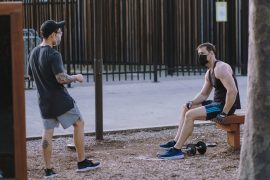
We’ve been living alongside COVID-19 for over 3 months now, and many are asking if we’ll ever get back to “normal life.” But what IS normal these days? While the act of grabbing a mask on the way out the door seemed foreign and awkward just a few months ago, today, many find it as natural as grabbing their keys or wallet as they head out.
As we come out of isolation, large group outings have been traded for small and intimate gatherings. Many are still self quarantining or choosing to interact with immediate family only. Restaurants and other businesses are finding ways to accommodate the public without jeopardizing their employees or patrons, allowing smaller numbers to enter at a time.
After so many months of quarantine, people are desperate for connection. We’ve begun to weigh the risk of exposing ourselves to COVID-19 against the negative impact this has had on our mental health. So how do you know what’s right for you? How do you decide what steps to take as the nation opens back up? And what do you do if you’re not ready?
First of all, it’s important to remember that it’s okay to feel uncertain about returning to socialization. What’s best for your neighbor might not be what’s best for you. It’s okay to be scared. With all change (even good change), comes apprehension. So if you find yourself feeling anxious about attending a party, eating at a restaurant, or doing some in person shopping for the first time in a long time, it’s okay. You’re not alone. These are unprecedented times, and we’re all learning as we go. Give yourself time to recognize and accept how you feel, and then decide what you want to do. If you decide to venture out into public, here are some tips that can help:
Permission To Create Safety For Yourself: Give yourself permission to leave situations that make you uncomfortable. If a group outing includes more people than you expected, or an outdoor event ends up in an enclosed space that you weren’t prepared for, know that it’s okay to leave on your own terms. Additionally, don’t be afraid to ask a lot of questions before you arrive, so that you have as much information as possible. We’re all in this together, and it’s natural to have more questions about get togethers than you might have prior to the stay at home order.
Boundaries: Socialize on your own terms. Don’t feel like you have to attend all of the outings, all of the time. Set good boundaries for yourself that you’re comfortable with, and only change them when YOU are ready. No one else gets to decide what you’re ready for. Maybe you’re most comfortable doing one essential outing and one social outing a week. Or, maybe you prefer to host people in your home so that you have better control over how many people you’re exposed to and the length of time you’re with them. Find what works for you. And don’t be afraid to change it up! What worked for you one week might not be what works the next. As you add new experiences and adapt, you’ll know what feels right for you.
Prepare & Keep Yourself Safe: Show up prepared.. Pack essential items that might help you feel safer. Masks, gloves, face-shields, your own water bottle and/or snacks. Simple precautions go a long way to keep us safe and help us feel more comfortable. That way, you’ll know that you have everything you need if you find yourself in a situation you feel unsafe in. Even if others are not wearing a mask, it’s ok to show up wearing one and may be the best choice for you. The new challenge is trying to get comfortable doing what is right for you. The City of Tampa just put in place an order mandating face masks indoors (in places other than homes) for everyone so likely more people will be wearing masks around which may help to normalize this for us all.
Seek Support: Share your apprehension with a close friend or family member who will be at the same social outing. Sometimes voicing our fears and limitations can decrease the power we give them. It also helps to know you’re not alone. It’s very likely that other people in the group are feeling the same way you are, and you can lean on each other for support.
Still worried about how getting out and being social again might affect you? Schedule an appointment with your therapist to discuss possible fears, outcome and solutions. Have realistic expectations for what might happen while you’re out and about, and have a plan of action, as opposed to having a negative reaction to the situation.
If you don’t have a therapist, we have a team of psychologists here at Wellness Psychologist Services who are accepting new patients for online telehealth. Contact us to set up your mental health intake today!
Next week, we’ll talk about what to do to keep your mental health in check if you choose to continue to self-quarantine.

